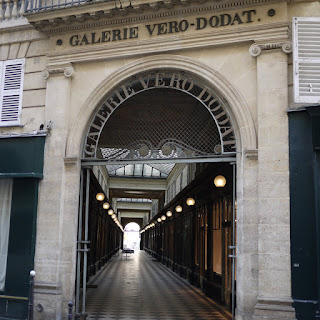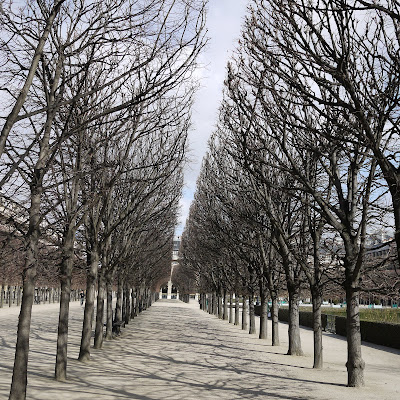This walk in "Paris inconnu", to quote our walk book, presents a tour of the city's 18th and 19th century arcades. You start at the Louvre and heading north soon reach the Galerie Vero-Dodat, opened in 1822 by two charcutiers called, reasonably enough, Vero and Dodat. The shop fronts have uniform round arches with slim brass columns and are very harmonious in a slightly faded way. Apparently this total concept of design was unusual at the time. The galerie was gas-lit from the 1830s and remained successful the rest of the century.

Emerging from Vero-Dodat you soon pass through an archway into the Palais-Royal, built for Cardinal Richelieu in 1629-35 by Jacques Lemercier. In the main courtyard, the Cour d'Honneur, there are a number of black and white striped columns of varying heights, mostly very low. They were installed by the conceptual artist Daniel Buren in 1986 and were titled by him "Les deux plateaux". They are, perhaps inevitably known, more prosaically as "les colonnes de Buren". The effect is quite interesting, although they do clash with the neo-classical architecture. They are clearly very popular however with small children, who could be seen jumping on and off the low ones.

The Palais-Royal is essentially rectangular and behind the Cour d'Honneur is a large court with galeried arcades on all sides and impressively marshaled lines of trees up the centre. We watched some girls practicing kick-boxing. It put us mind of scenes we had observed in the Gate of Heaven park in Beijing.

Leaving the palace, you soon reach the Galerie Vivienne, the most interesting one on this walk. It is 193 yards long and dates from 1826. We especially liked the beautiful mosaic floor.

At the end you are supposed to double back into the Galerie Colbert. This now seems to be offices, rather than the usual shops, and we had to sweet talk the security guard to be allowed access. "C'est juste un couloir" she said, but it was in fact more than a corridor, it was a heavily restored neoclassical gem.
After a stretch of road and a restoring patisserie, next up was the workaday Galerie Choiseul. Some more fairly ordinary streets led to another treasure, the Passage des Panoramas. One of the oldest in Paris, this was opened in 1800 by an American inventor named Robert Fulton. It still retains its vitality, perhaps especially as a result of the profusion of shop signs.

From here you cross the road and go straight into the Passage Jouffroy of 1847 - you can see the date in the handsome clock at the end of the first section - the arcade then makes a dogleg turn to continue.

At the end you cross another road to enter the Passage Verdeau of 1846. This sequence of passages felt like a secret route through the city. The route soon then passed by the wonderful Brasserie Flo, where we temporarily abandoned our study of the arcades to enjoy an excellent lunch in its ornate surroundings.
The next section is frankly a bit boring and the next arcade, the Passage Brady, is terribly rundown. You then come to the imposing Porte St Denis, built in 1672 by Francis Blondel. Its splendour is explained by its role as the king's official entrance to the city. Approached from this side it is wonderfully out of proportion with the narrow street.

The end of the walk was rather anti-climatic. The final passage was to be the oldest and longest in Paris - the Passage du Caire of 1799. However, it was locked and looked very dull, being devoted to wholesale clothes merchants.
From: Gilles Desmonds - Walking Paris (New Holland).
Conditions: cloudy, very cold.
Rating: three and a half stars. A different view of Paris, but quite a lot of tramping along undistinguished streets.

No comments:
Post a Comment